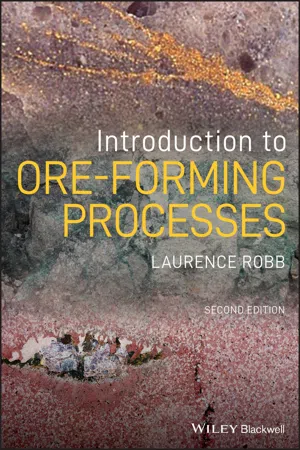
- English
- ePUB (mobile friendly)
- Available on iOS & Android
Introduction to Ore-Forming Processes
About this book
A comprehensive account of ore-forming processes, revised and updated
The revised second edition of Introduction to Ore-Forming Processes offers a guide to the multiplicity of geological processes that result in the formation of mineral deposits. The second edition has been updated to reflect the most recent developments in the study of metallogeny and earth system science.
This second edition contains new information about global tectonic processes and crustal evolution that continues to influence the practice of economic geology and maintains the supply of natural resources in a responsible and sustainable way. The replenishment of depleted natural resources is becoming more difficult and environmentally challenging. There is also a change in the demand for mineral commodities and the concern around the non-sustainable supply of 'critical metals' is now an important consideration for planners of the future. The book puts the focus on the responsible custodianship of natural resources and the continuing need for all earth scientists to understand metallogeny and the resource cycle. This new edition:
- Provides an updated guide to the processes involved in the formation of mineral deposits
- Offers an overview of magmatic, hydrothermal and sedimentary ore-forming processes
- Covers the entire range of mineral deposit types, including the fossil fuels and supergene ores
- Relates metallogeny to global tectonics by examining the distribution of mineral deposits in space and time
- Contains examples of world famous ore deposits that help to provide context and relevance to the process-oriented descriptions of ore genesis
Written for students and professionals alike, Introduction to Ore-Forming Processes offers a revised second edition that puts the focus on the fact that mineral deposits are simply one of the many natural wonders of geological process and evolution.
Frequently asked questions
- Essential is ideal for learners and professionals who enjoy exploring a wide range of subjects. Access the Essential Library with 800,000+ trusted titles and best-sellers across business, personal growth, and the humanities. Includes unlimited reading time and Standard Read Aloud voice.
- Complete: Perfect for advanced learners and researchers needing full, unrestricted access. Unlock 1.4M+ books across hundreds of subjects, including academic and specialized titles. The Complete Plan also includes advanced features like Premium Read Aloud and Research Assistant.
Please note we cannot support devices running on iOS 13 and Android 7 or earlier. Learn more about using the app.
Information
Part I
Igneous Processes
1
Igneous Ore‐Forming Processes
Topics
- “late‐veneer” hypothesis
- diamonds and kimberlite/lamproite
- metal concentrations in metasomatized mantle
- S‐ and I‐type granites
- sulfide solubility
- sulfide–silicate partition coefficients
- the R factor
- PGE clusters and hiatus models
Case Studies
- Box 1.1 Diamondiferous Kimberlites and Lamproites: The Orapa Diamond Mine, Botswana and the Argyle Diamond Mine, Western Australia
- Box 1.2 Carbonatites and Alkaline Intrusions as Sources of Critical Metals
- Box 1.3 Partial Melting and Concentration of Incompatible Elements: The Rössing Uranium Deposit
- Box 1.4 Boundary Layer Differentiation in Granites and Incompatible Element Concentration: The Zaaiplaats Tin Deposit, Bushveld Complex
- Box 1.5 Crystal Fractionation and Formation of Monomineralic Chromitite Layers: The UG1 Chromitite Seam, Bushveld Complex
- Box 1.6 Addition of External Sulfur and Sulfide Immiscibility: The Komatiite‐Hosted Ni–Cu Deposits at Kambalda, Western Australia
- Box 1.7 New Magma Injection and Magma Mixing: The Merensky Reef, Bushveld Complex
- Box 1.8 Magma Contamination and Sulfide Immiscibility: The Sudbury Ni–Cu Deposits
1.1 Introduction
| Mineralization hosted in | Area (km2) | Value of sales, 1971 (106 US$) | % of total area | % of total value | Unit value (US$ km−2) |
| Granites | 163 100 | 1 973 | 13.3 | 3.4 | 12 000 |
| Mafic layered complexes | 36 400 | 7 288 | 3.0 | 12.5 | 200 200 |
| Total (igneous) | 199 500 | 9 261 | 16.3 | 15.9 | 46 400 |
| Sedimentary rocks | 1 023 900 | 49 137 | 83.7 | 84.1 | 47 900 |
1.2 Magmas and Metallogeny
1.2.1 Crustal Architecture and Mineral Wealth
Table of contents
- Cover
- Table of Contents
- Preface to the 2nd Edition
- Preface to the 1st Edition
- Introduction: Mineral Resources
- Part I: Igneous Processes
- Part II: Hydrothermal Processes
- Part III: Sedimentary/Surficial Processes
- Part IV: Global Tectonics and Metallogeny
- References
- Index
- End User License Agreement